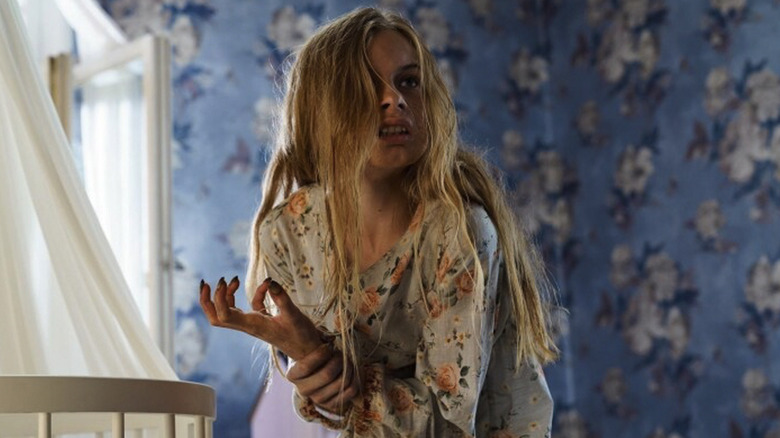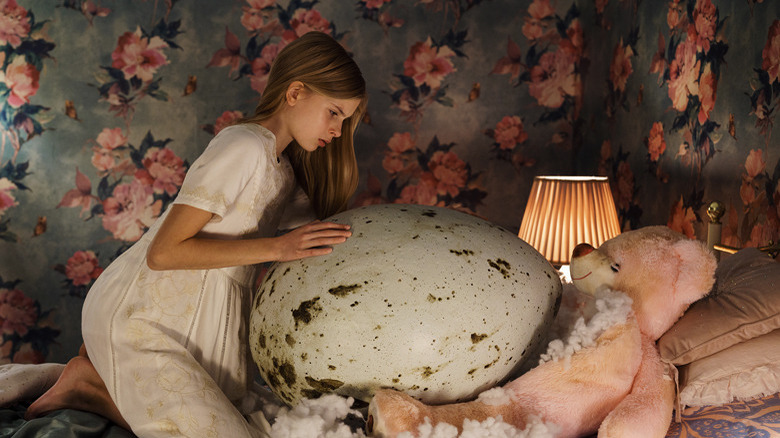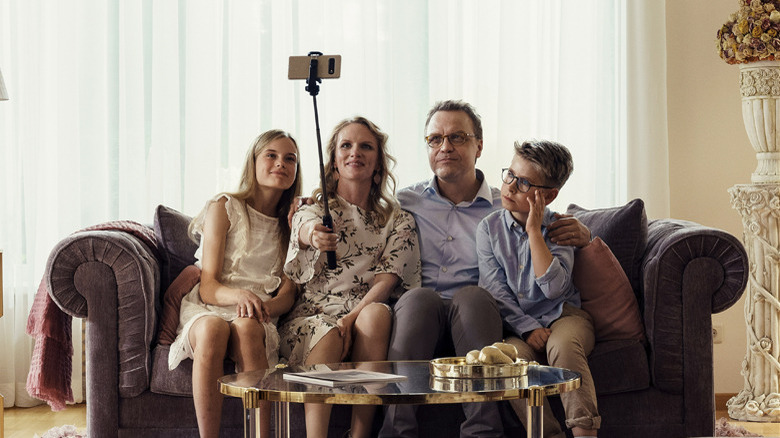Hatching Review: Practical Effects Enhance This Striking Creature Feature [Sundance 2022]
Twelve-year-old Tinja, an aspiring gymnast, stretches in her family's pristine living room. It almost feels more like a showroom than a familiar space where people actually live, and the camera sneaks closer to the girl, winding past a marble statue, two ottomans, a glass coffee table, and under a chandelier until it finally reaches her. Tinja's mother, who's been holding the camera the whole time, spins the lens onto herself as she tickles her daughter with a giant smile plastered on her face. She's a vlogger obsessed with presenting a "perfect" vision of a traditional Finnish family, so that long before the film's grotesque creature shows up, it's clear this is a horror movie.
Flanked on the couch by her excruciatingly boring husband (Jani Volanen), their younger son Matias (Oiva Ollila), and Tinja (Siiri Solalinna), Mother (Sophia Heikkilä) delivers a sickly sweet address to her selfie stick: "I hope your everyday life is as lovely as ours." But the family's fake smiles are interrupted when a bird smashes into their window and eventually bursts into their living room, kicking off a series of events that will radically challenge the phony reality they're presenting to the world.
Tinja manages to catch the bird by tossing a blanket over it, but in case we needed further confirmation that the family's online lives are a lie, her mom instantly snaps the bird's neck, giving us some insight into the way Mother deals with things that don't conform to her perfectly manicured vision. After discarding the body in the trash ("organic waste," Mother clarifies), Tinja hears pained cawing coming from the woods outside their house at night. After a brief search, she discovers the bird somehow didn't die when its neck was snapped — it made its way back to its nest, where it's protecting an egg. Is the zombie bird real in this moment, or just a twisted vision? Either way, Tinja is drawn to the egg, which she takes home and promises to care for. But it's not long before Tinja realizes this is no normal egg.
The Thrill of Practical Effects
The egg soon grows to be the size of a bean bag chair, and when it hatches, the film finally settles into its groove. A large bird-like creature emerges from the egg, dripping with sticky goo and patches of mottled hair, like some sort of decaying Skeksis character from Jim Henson's "The Dark Crystal." It's created using practical effects, and in an era in which filmmakers too often rely on CGI to create characters like this, it's genuinely thrilling to watch Tinja interact with a tangible thing right in front of our eyes — even when she's gorging herself on birdseed and vomiting it back up in order to feed the creature.
Tinja and her unconventional pet are connected both mentally and physically. When one experiences pain, so does the other, and at first it seems as if the bond they have is something akin to the one shared by Elliott and E.T. (and like Elliott, Tinja tries to keep her newfound pal hidden in her closet). But their mysterious link is darker than that: When Tinja is annoyed by something — a barking dog, a new neighbor performing better than her in gymnastics class — the creature goes on the hunt and inflicts the type of damage Tinja could never dream of doing herself. And as pressures build in Tinja's life, the attacks become more intense.
An Effective Metaphor
Despite Mother's predilection for filming her family, director Hanna Bergholm isn't interested in delivering a scathing screed against vlogging culture here; instead, she uses it as a shortcut to interrogate unrealistic expectations placed on women of all ages, and how those burdens inevitably lead to cracks in the seams. As the creature slowly sheds its bird-like image and morphs into the spitting image of Tinja — featuring some nasty makeup effects mid-transition with teeth embedded in the side of its face, making it seem like this thing and the death bear from "Annihilation" might have a lot to chat about on a first date — it becomes clear that the shared connection between Tinja and this creature is a metaphor for puberty. Tinja isn't just tied to this thing — she is this thing. (At one point, Tinja is trying to hide the creature under her bed when her father comes in her room, spots a drop of blood on her sheets, assumes she's had her first period, and backs out of the room, making the metaphor textual.)
Ilja Rautsi's screenplay keeps the plotting relatively tight throughout, but despite the movie's 86-minute runtime, it also feels like it hammers the same points home a few too many times. While it doesn't break any new ground in the horror space or do anything super mind-blowing from a narrative perspective, "Hatching" is a successful (if somewhat flat) exploration of that transitional period in one's life when an earlier version of yourself dies and a new version stands in its place.
/Film Rating: 7 out of 10


